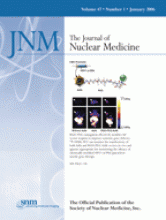The work by Capello et al. (1) published in this issue of the Journal of Nuclear Medicine demonstrates an important paradigm shift currently invading investigations and practice in oncology: the use of 2 biologic agents to achieve therapeutic synergy by coactivation or blockade of cancer cell signaling pathways. This publication presents a careful study of a creatively linked multifunctional radiopharmaceutical. The study is on pharmacokinetics and tumor cell effects elicited by the linkage of octreotate, a somatostatin analog, with RGD (Arg-Gly-Asp) peptides, antagonists of the αvβ3 integrin receptors found uniquely on neovascular cells and See page 122
epithelial tumors. The RGD-111In-diethylenetriaminepentaacetic acid (DTPA)-octreotate radiopharmaceutical was studied in vitro and in mice, with focus on uptake and apoptosis responses in somatostatin receptor subtype 2–positive tissues and tumors.
Why should this study be considered intriguing?
Enhancement of immunotherapy and radioimmunotherapy has recently been demonstrated by the use of combined molecular targeting. Various combinations of anti-CD22, anti-CD20 (rituximab), anti-1D10 (apolizumab), and anti-HLA-Dr lymphoma monoclonal antibodies have suggested increased efficacy in aggressive disease in vitro and in preliminary patient studies (2,3). The efficacy of radioisotope therapy (RIT) delivered on an anti-LewisY monoclonal antibody was enhanced by use of a tyrosine kinase that inhibited signaling of epidermal growth factor receptor during RIT in animals (4). These and other studies of targeted therapy combinations, including RIT, have demonstrated unique promise but also provide challenges related to the sequence, timing, and dosage necessary to enhance efficacy and reduce overlapping toxicities.
Any molecular targeted cancer therapy that has a demonstrated tumor effect and an enhanced therapeutic index over previous therapies is a prime candidate for studies of synergy with a second molecular targeted agent. As mentioned by Capello et al. (1), various radiolabeled ligands for somatostatin receptors have provided therapy and several have demonstrated useful, albeit temporary, clinical responses (5–7). Clinical trials with 111In-DTPA-octreatate were encouraging, with evidence of stable disease; 90Y-1,4,7,10-tetraazacyclododecane-N,N′,N″,N″′-tetraacetic acid (DOTA)-Tyr3-octreotide demonstrated some tumor regressions; and treatment with a 177Lu-DOTA-Tyr3-octreotate resulted in temporary remissions in a high percentage of patients, with only rare serious side effects (7).
Therefore, these receptor-internalized radioligands provide an excellent opportunity to attempt further coactivation of apoptosis in tumor cells by the addition of an RGD peptide to the radioactive octreotate pharmaceutical. This is of particular interest because one of the more promising strategies in several clinical trials for enhancing chemotherapy is the addition of antiangiogenic drugs to therapeutic regimens. Importantly, antagonists of αvβ3 integrin receptors, such as this RGD peptide ligand, induce apoptosis in vascular endothelium in only newly sprouting vessels, not in mature, preexisting vessels (8). The effects of RGD may result from blocked signaling of αvβ3 integrin required for certain cells to survive, as well as from the demonstrated ability of RGD to directly activate cytoplasmic procaspase 3 and thus initiate the induction of apoptosis of that cell (9). Previous reports of RGD given intraperitoneally to mice before intravenous 111In-monoclonal antibody demonstrated a significant increase in tumor uptake but no change in normal organ uptake or in body or blood clearance (10). In mouse studies of RGD–RIT synergy, significantly increased cure rates for RIT with RGD and increased cellular apoptosis was demonstrated in an aggressive-breast-cancer model negative for cancer cell αvβ3 (11). The increased vascular cell apoptosis observed with this combination was consistent with endothelial cell death affecting tumor cell death and thus contributing to the observed increase in cures (11). The enhanced therapeutic synergy is of particular note, having been achieved without additional toxicity. In other studies on mice, Arap et al. demonstrated targeting of tumor vasculature in breast cancer xenografts using RGD-containing phage linked to doxorubicin (12). This resulted in long-term survival of mice treated with doxorubicin-RGD peptide, compared with mice treated with doxorubicin alone, indicating that the linked peptide inhibited primary tumor growth and metastasis.
The investigators using RGD-111In-DTPA-octreotate hypothesized that the enhanced apoptosis resulted from internalization of the multiligand by somatostatin receptors, followed by intracellular direct RGD activation of procaspase 3. However, uptake of the radiolabeled agent in kidneys was considered indicative that RGD-111In-DTPA-octreotate would not provide safe therapy. Perhaps approaches that retain the increased efficacy and bypass renal toxicity can be devised using multiple doses, predose variants, or timing manipulations.
Molecular imaging provides unique opportunities. Recent publications have demonstrated that 18F-galacto-RGD allows quantification of αvβ3 expression in vivo and suggest that molecular imaging should be a consideration in deriving effective combination therapy involving this integrin. Tumor-induced angiogenesis or uptake of RGD radiopharmaceuticals in multiligand formats can now be monitored in murine tumor models by PET using the type of tracer described for noninvasive determination of αvβ3 expression (13,14). PET studies of 18F-galacto-RGD in patients with malignant tumors have also demonstrated noninvasive quantitative assessment of the αvβ3 expression pattern on tumor and endothelial cells. Thus, quantitative molecular imaging with multitargeted drugs containing RGD can provide important dose and time sequence information for development of effective therapy and clinical monitoring of these therapies. Because this offers the potential to combine multiple cell-death signals in both tumor and neovascular cells, the new evidence of sensitive quantitative PET with RGD analogs is of note.
Along with this new opportunity to develop synergistic therapy come the challenging complexities of the cellular systems regulating these targets. The article of Capello et al. (1) demonstrates evidence of enhanced apoptosis and possible mechanisms of therapeutic synergy, but determining the true potential of such therapy with hybrid multitargeted radiolabeled RGD-octreotate agents awaits further study. Such combinations provide new dimensions for radionuclide cancer therapy as part of molecular targeted regimens.
References
- Received for publication October 6, 2005.
- Accepted for publication October 12, 2005.







